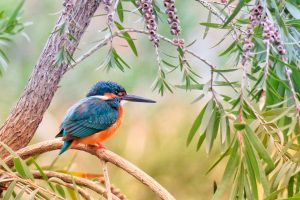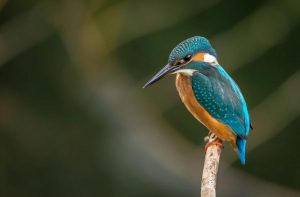There’s only one type of kingfisher in the UK, and it is a fantastic little bird with its beautiful, metallic blue and orange plumage – it’s a real treat to see one of these chappies as they swoop towards the water, that’s for sure…
In the UK, you’ll find that the kingfisher likes to live near water – preferably slow-moving rivers or motionless clean water in lowland areas, if possible.
Occasionally they may venture away from their usual habitats, but that’s only because their food supplies may be in short and guess where they head? The coastal areas, surprise, surprise!

Fish!
And the reason for their watery interest? Fish, of course!
Any fast-moving streams and dirty and polluted waters don’t contain enough available fish, and therefore don’t provide for kingfishers.
And any branches which overhang shallows make essential fishing perches for these very particular birds.
An ideal fishing spot for the kingfisher is a firm woody perch overlooking a clear, shallow pool of water.
Once the kingfisher has located a suitable fishy prey and has assessed its depth, it swoops in and dives.
At the entry into the water, the kingfisher opens its beak and closes its eyes closed by the third eyelid, which effectively blindfolded the kingfisher as it catches the fish.
Once its returned to its perch, the kingfisher repeatedly strikes the fish against the wood to kill it.
Only then will the spines in the fins of some fish species (which includes sticklebacks and minnows amongst many) relax enough to allow the bird to swallow it, head-first.

A Big Diet
Each kingfisher must eat at least its bodyweight of fish each day – that’s a lot of fish. This equates to about a 100 fish a day – that’s a lot of fishin’.
Kingfishers tend to like to have their own fishing spot as they need their food for survival – so, they aren’t very keen on socialising with other kingfishers and seem quite territorial.
If kingfishers are having a bad fishing day, they will stoop to eat aquatic insects, freshwater shrimps, and tadpoles – but at a push…!
